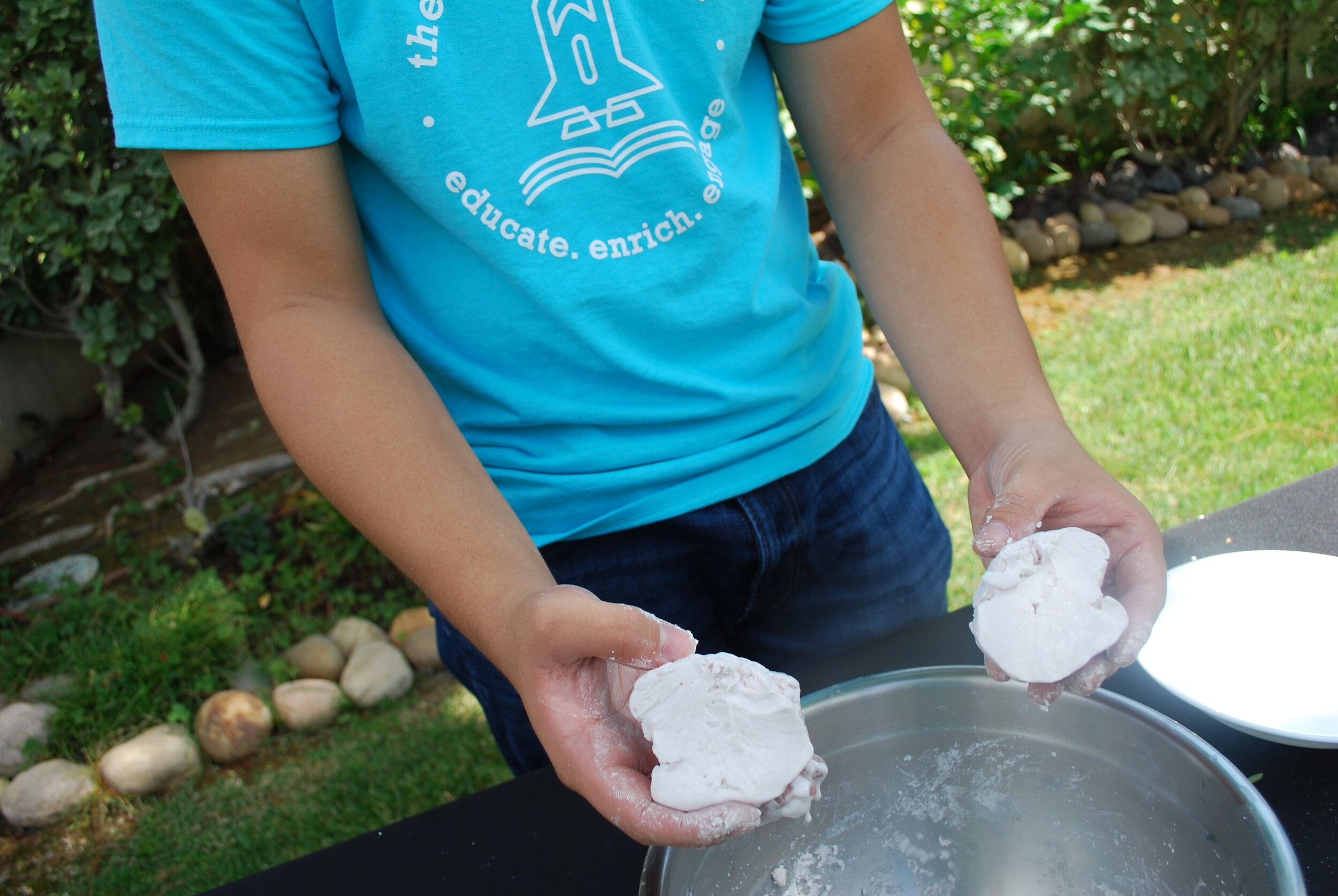Color Changing Oobleck
Use chemistry and the properties of pH to create oobleck that can change colors! Watch how these colors interact and learn more about the way the acids and bases react with one another!
Materials
Cornstarch
Half a Head of Red Cabbage
Water
White vinegar
Baking Soda
Pot or saucepan
Strainer
Bowl
Cups
Syringes, Pipettes, Straws or Spoons
Procedure
Step 1
Fill a pot or saucepan with water and set it to boil on the stove
Step 2
Chop red cabbage and put into the pot of boiling water. Let boil for approximately 10 minutes until the color has been transferred from the cabbage to the water. Strain cabbage liquid into desired container for later.
Step 3
In a large bowl, mix together 1½ cups of cornstarch and ½ cup of the red cabbage liquid.
Mix the two until a play dough consistency is reached, adding cornstarch if the mixture is too runny and adding cabbage liquid if the mixture is too stiff. It should not feel like oobleck just yet. NOTE: If the bowl is clouded, transfer to a clear bowl or tray for ease of viewing the color changing process
Step 4
Separate the dough into two so that we can change each of the colors individually
Step 5
Get two cups. Fill one with a few tablespoons of white vinegar. In the other cup, create a mixture with 1 part baking soda to 2 parts water (for example, 1 tablespoon baking soda and 2 tablespoons water). Mix to dissolve.
Step 6
Now using a syringe, pipette, straw, or spoon - add the vinegar to one of the pieces, and the baking soda mixture to the other. Be sure to use a different pipette/straw/spoon for each of the mixtures!
Step 7
Mix the liquids with the pieces with your hands and watch the color changing process unfold! Add more solution as needed to strengthen the presence of the respective color. The vinegar side should be pink, and the baking soda side should be blue.
Step 8
Now mix the two! Watch how the two colors interact, as well as how the oobleck behaves! Be careful! This chemical reaction is exothermic; it releases heat.
Science Explanation
Kindergarten - 2nd Grade . . .
- NGSS 2-PS1-1
- When we first boil the water, what kind of matter is it? (Answer: Liquid)
- When we increase the temperature by turning the stove on, what does the liquid water turn into? (Answer: Gas)
- Our red cabbage solution tells us whether a substance is an acid or a base. That is why our oobleck changes colors when we add our vinegar and baking soda solutions. The vinegar turns the oobleck pink, and the baking soda turns the oobleck blue. But why is this?
- When you bite into a lemon, what does it taste like? Is it sour or is it sweet? (Answer: sour)
- This sour taste is because the lemon is acidic. A lot of acidic items taste sour (But never taste unknown substances as they could be TOO acidic).
- Between our baking soda solution and vinegar, which do you think might be acidic like our sour lemon? (Answer: Vinegar)
- The opposite of acidic is known as basic or alkaline.
- A common example of a basic substance is soap.
- Because we know that our vinegar is acidic, do you think our baking soda solution is an acid or a base? (Answer: Base)
- As we know from the experiment, our baking soda solution turns the oobleck blue. This is because it is a base, turning the red cabbage solution in the oobleck blue.
- Additionally, we found that the white vinegar turned the oobleck pink. This is because it is an acid, turning the red cabbage solution in the oobleck pink.
3rd Grade - 5th Grade . . .
- NGSS 4-PS3-2, NGSS 5-PS1-1, NGSS 5-PS1-4
- When we boil the water, what type of energy is being emitted from the stove? (Answer: Heat)
- The color changing aspect of this experiment is related to the interaction of acids and bases.
- Our white vinegar acts as an acid, and our baking soda solution acts as a base.
- Both of these substances interact differently with the red cabbage solution, the acid turning a pink color, and the base turning a blue color.
- But what is the difference between acids and bases?
- As we know, matter can be defined as many small particles that are very close together.
- In a gas, the particles are very far apart, and in a solid, the particles are very close to one another.
- In vinegar solution, there are also particles, and certain types of these particles are the reason behind why it is an acid.
- These particles are H+ ions, kind of like the H in water (H2O)!
- Having more of these H+ ions makes a solution more acidic, and likewise, having fewer of these H+ ions makes a solution more basic, like our baking soda solution.
- A scale is used to measure how many H+ ions a solution has, and it is known as the pH scale, which runs from 0 to 14!
- Our white vinegar has more H+ ions because it is acidic. Because of this, it is lower on the pH scale.
- The baking soda solution has fewer H+ ions because it is basic. Because of this, it is higher on the pH scale.
- The red cabbage solution what we put into the oobleck detects the pH of the substance, turning pink when reacting with low pH (Vinegar), and turning blue when reacting with high pH (Baking soda).
* Congrats on finding the LMA clue. For proof, take a pic of your shoe!
Math Extensions
Kindergarten . . .
- Count the number of materials we are using for this experiment. How many are there? (Answer: 11)
- In our baking soda solution, is the amount of baking soda we add greater than or less than the amount of water we add? (Answer: less than)
CCSS.MATH.CONTENT.K.CC.B.5
CCSS.MATH.CONTENT.K.CC.C.6
4th Grade . . .
- We added 1½ cups of cornstarch and ½ cups of cabbage liquid to our mixing bowl. Express these values in decimal form. (Answer: 1.5 cups and 0.5 cups)
CCSS.MATH.CONTENT.4.NF.C.5
CCSS.MATH.CONTENT.4.NF.C.6
6th - 8th Grade . . .
- What is the ratio of baking soda to water that we used in our baking soda solution? (Answer: 1:2)
CCSS.MATH.CONTENT.6.RP.A.1
Written by Ethan Kirgan From our friends at STEAM Powered Family









